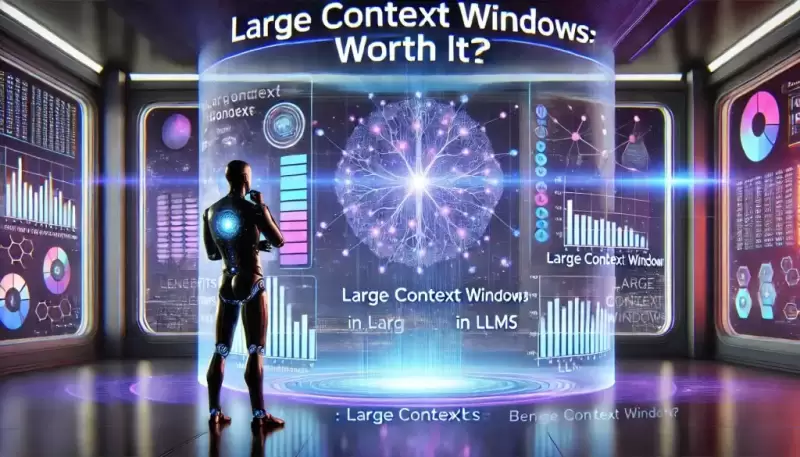 |
|
 |
|
 |
|
 |
|
 |
|
 |
|
 |
|
 |
|
 |
|
 |
|
 |
|
 |
|
 |
|
 |
|
 |
|
Cryptocurrency News Articles
The race to expand large language models (LLMs) beyond the million-token threshold has ignited a fierce debate in the AI community.
Apr 13, 2025 at 03:30 am
Models like MiniMax-Text-01 boast 4-million-token capacity, and Gemini 1.5 Pro can process up to 2 million tokens simultaneously.

The race to expand large language models (LLMs) beyond the million-token threshold has ignited a fierce debate in the AI community. Models like MiniMax's MiniMax-Text-01 boast a 4-million-token capacity, and Gemini 1.5 Pro can process up to 2 million tokens simultaneously, setting a new standard in parallel processing. These models now promise game-changing applications, like analyzing entire codebases, legal contracts or research papers in a single inference call.
At the core of this discussion is context length — the amount of text an AI model can process and also remember at once. A longer context window enables a machine learning (ML) model to handle much more information in a single request and reduces the need for chunking documents into sub-documents or splitting conversations. For context, a model with a 4-million-token capacity could digest 10,000 pages of books in one go.
In theory, this should mean better comprehension and more sophisticated reasoning. But do these massive context windows translate to real-world business value?
As enterprises weigh the costs of scaling infrastructure against potential gains in productivity and accuracy, the question remains: Are we unlocking new frontiers in AI reasoning, or simply stretching the limits of token memory without meaningful improvements? This article examines the technical and economic trade-offs, benchmarking challenges and evolving enterprise workflows shaping the future of large-context LLMs.
Why are AI companies racing to expand context lengths?
The promise of deeper comprehension, fewer hallucinations and more seamless interactions has led to an arms race among leading labs to expand context length.
For enterprises, this means being able to analyze an entire legal contract to extract key clauses, debug a large codebase to identify bugs or summarize a lengthy research paper without breaking context.
The hope is that eliminating workarounds like chunking or retrieval-augmented generation (RAG) could make AI workflows smoother and more efficient.
Solving the ‘needle-in-a-haystack’ problem
The "needle-in-a-haystack" problem refers to AI's difficulty in identifying critical information (needle) hidden within massive datasets (haystack). LLMs often miss key details, leading to inefficiencies.
Larger context windows help models retain more information and potentially reduce hallucinations. They also help in improving accuracy and enabling novel use cases:
Increasing the context window also helps the model better reference relevant details and reduces the likelihood of generating incorrect or fabricated information. A 2024 Stanford study found that 128K-token models exhibited an 18% lower hallucination rate compared to RAG systems when analyzing merger agreements.
However, early adopters have reported some challenges. For instance, JPMorgan Chase's research demonstrates how models perform poorly on approximately 75% of their context, with performance on complex financial tasks collapsing to nearly zero beyond 32K tokens. Models still broadly struggle with long-range recall, often prioritizing recent data over deeper insights.
This raises questions: Does a 4-million-token window truly enhance reasoning, or is it just a costly expansion of memory? How much of this vast input does the model actually use? And do the benefits outweigh the rising computational costs?
What are the economic trade-offs of using RAG?
RAG combines the power of LLMs with a retrieval system to fetch relevant information from an external database or document store. This allows the model to generate responses based on both pre-existing knowledge and dynamically retrieved data.
As companies adopt LLMs for increasingly complex tasks, they face a critical decision: Use massive prompts with large context windows, or rely on RAG to fetch relevant information dynamically.
Comparing AI inference costs: Multi-step retrieval vs. large single prompts
While large prompts offer the advantage of simplifying workflows into a single step, they require more GPU power and memory, rendering them costly at scale. In contrast, RAG-based approaches, despite requiring multiple retrieval and generation steps, often reduce overall token consumption, leading to lower inference costs without sacrificing accuracy.
For most enterprises, the best approach depends on the use case:
A large context window is valuable when:
Per Google research, stock prediction models using 128K-token windows and 10 years of earnings transcripts outperformed RAG by 29%. On the other hand, GitHub Copilot's internal testing showed that tasks like monorepo migrations were completed 2.3x faster with large prompts compared to RAG.
Breaking down the diminishing returns
The limits of large context models: Latency, costs and usability
While large context models offer impressive capabilities, there are limits to how much extra context is truly beneficial. As context windows expand, three key factors come into play:
Google's Infini-attention technique attempts to circumvent these trade-offs by storing compressed representations of arbitrary-length context within bounded memory. However, compression leads to information loss, and models struggle to balance immediate and historical information. This leads to performance degradations and
Disclaimer:info@kdj.com
The information provided is not trading advice. kdj.com does not assume any responsibility for any investments made based on the information provided in this article. Cryptocurrencies are highly volatile and it is highly recommended that you invest with caution after thorough research!
If you believe that the content used on this website infringes your copyright, please contact us immediately (info@kdj.com) and we will delete it promptly.
-

-

-
![Bitcoin [BTC] Is at a Pivotal Juncture. This Long-Term Metric Will Determine the Next Market Narrative. Bitcoin [BTC] Is at a Pivotal Juncture. This Long-Term Metric Will Determine the Next Market Narrative.](/assets/pc/images/moren/280_160.png)
- Bitcoin [BTC] Is at a Pivotal Juncture. This Long-Term Metric Will Determine the Next Market Narrative.
- Apr 13, 2025 at 10:20 pm
- Bitcoin [BTC] is at a pivotal juncture. As one of its most telling long-term metrics approaches a historically significant level, the market finds itself holding its breath.
-

-

-

-

-

-

- Bitcoin May Be Approaching a Significant Turning Point. These 5 Cryptos Could Multiply Your Investment by 500x
- Apr 13, 2025 at 10:05 pm
- Bitcoin may be approaching a significant turning point. Signals from major investors and historical trends point to a possible explosive growth ahead. Five cryptos stand out.





















































![Bitcoin [BTC] Is at a Pivotal Juncture. This Long-Term Metric Will Determine the Next Market Narrative. Bitcoin [BTC] Is at a Pivotal Juncture. This Long-Term Metric Will Determine the Next Market Narrative.](/uploads/2025/04/13/cryptocurrencies-news/articles/bitcoin-btc-pivotal-juncture-term-metric-determine-market-narrative/middle_800_480.webp)





